How to make your own Sourdough Starter, using simple ingredients with no special equipment, in just 6 days, that can be used in sourdough bread. Sourdough Starter is a “wild” yeast, made from flour, water and the wild yeast in the air around us- used to replace store-bought yeast. (Step-by-step VIDEO.)
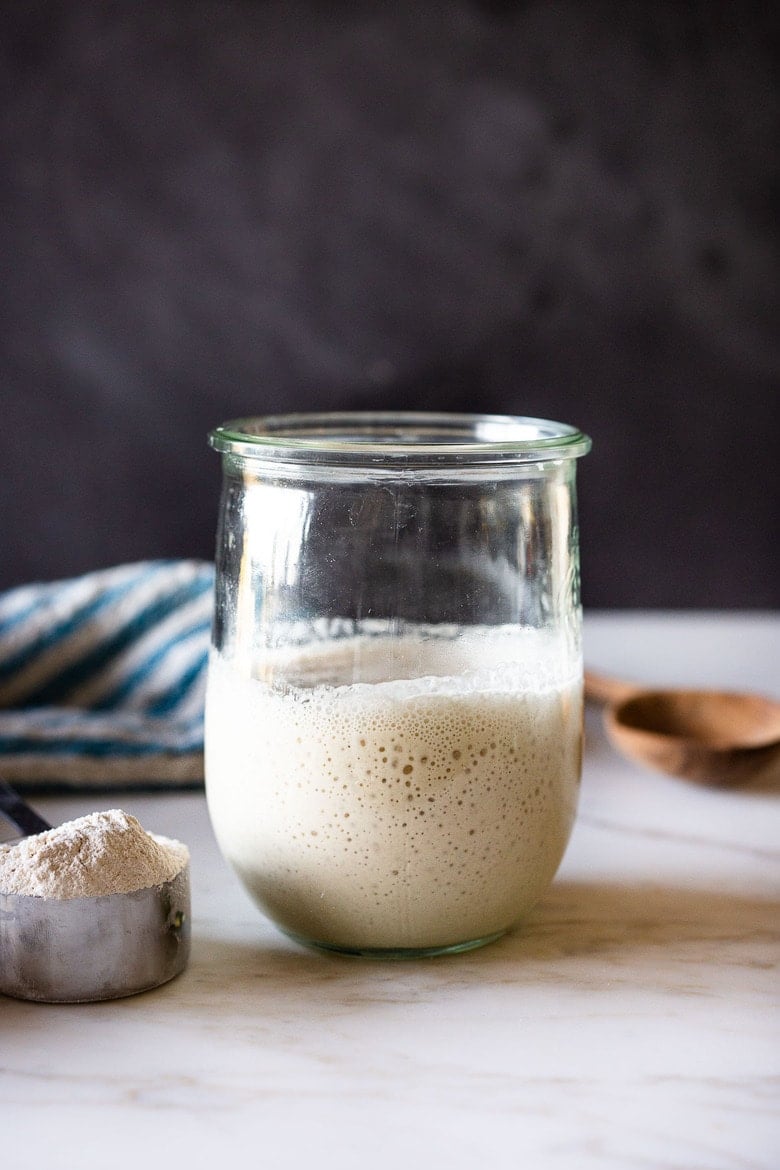 When you understand one thing through and through, you understand everything.~ Shunryu Suzuki
When you understand one thing through and through, you understand everything.~ Shunryu Suzuki
Hey friends, I’ve wanted to share this recipe for Sourdough Starter for years now, and with most of us being homebound, and without yeast available at the grocery stores, I thought this might be the perfect time to post it. As you know, we are in Santa Barbara for the winter, and one thing I didn’t even think to bring with me was my sourdough starter.
I made a fresh batch of starter last week, and baked a loaf of Sourdough Bread yesterday- and felt so much joy from this simple pleasure. The whole process honestly fills me with such wonder. How gloriously alive the world is! Plus there really is nothing like the smell of fresh bread to lift the spirits.
If you find yourself with a little more time on your hands, this might be the perfect opportunity to discover the joy of baking sourdough bread from your very own sourdough starter. You can also make baguettes, pizza dough, waffles, banana bread, pancakes,crackers, sourdough buns, sourdough tortillas and biscuits.
It’s truly incredible! The basic instructions were taught to me by a friend, who adapted it from Breadtopia and King Arthur Flour. I’ve taken liberties and further adapted, but both are great resources.
How to Make Sourdough Starter | 20-Min Video
***Don’t see the video? Allow 15-20 seconds to load it right here!*** (Still don’t see it? Check that your ad blocker is turned off.)
Fast forward to Specific Day by video time (using scroll bar underneath video)
- Day 1 Morning: :23
- Day 2 Morning: 4:10
- Day 3 Morning: 7:00
- Day 3 Evening: 9:12
- Day 4 Morning: 11:50
- Day 4 Evening: 13:37
- Day 5 Morning: 14:45
- Day 6 Evening: 16:50
- Day 6 Morning: 18:12
- Day 6 Evening: 20:10
What you’ll need
- Jar- A wide-mouth quart jar or a Weck’s 1-liter tulip jar.
- Flour – 5 lb bag of organic bread flour (plus 1 cup organic whole grain flour -optional)
- Water– filtered water, tap water, or mineral water (specifically, San Pellegrino, for the correct mineral ratio). Distilled water does not have enough minerals.
- Scale– using a kitchen scale is optional but handy.
- Thermometer– Knowing the temp of the starter using a thermometer is optional but handy!
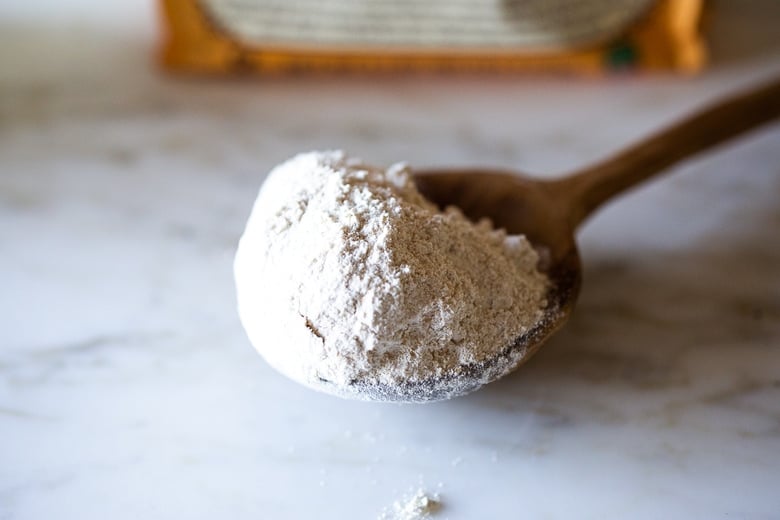
What is a Sourdough Starter?
- Think of sourdough starter as yeast. Only in this case, instead of buying a packet of yeast from the store, you are making your own living “wild yeast” by fermenting flour and water. That is it! ONLY 2 ingredients! Once it’s alive, it is like a very low-maintenance pet.
- You must feed it (stir in a mixture of flour and water) once a week to keep it healthy and happy. You know it’s happy when it bubbles. 😉 And YES, you can even name it.
- Some people believe that bread made with sourdough starter is actually better for you than bread made with yeast. Here and Here are a few articles to get you started on your own research. While I’m not sure if this is scientifically proven, I do know that bread made with sourdough starter, tastes infinitely better, feels easier to digest, and has more complexity and better texture, than bread made with commercial yeast. So if you are a bread lover- this is absolutely the way to go, as far as the quality of your finished bread.
What is Feeding?
- Feeding your sourdough starter is basically adding a mixture of flour and water to your existing starter, to keep it alive, happy, and nourished. Starter is full of wild yeasts that get hungry, just like we do. These yeasts need “food” -in this case, more flour, to stay healthy and active.
- How often you feed depends greatly on the temperature of your home. The starter will metabolize the flour more quickly in warm environments, and more slowly in cold environments (like the fridge). If you keep your starter in the fridge, you should only need to feed it once a week. If you keep it on the counter you may need to feed it 1-2 times daily, and sometimes more if you live in warmer climates.
Sourdough Starter (step-by-step instructions)
This recipe for Sourdough Starter takes 6 days (or up to 12 days if cold) and is very easy. This was the way I was taught and it always works for me. There are plenty of more complicated recipes out there, and I get it, if that is more your style – or you feel like completely nerding -out (a good thing, and this is the time!) dive in. Feed your fancy! Or watch the 20-minute Sourdough Video above!
Day 1: Staring in the morning or at night, using a wide-mouth quart jar, tulip jar, or Crock or Glass Measuring Cup , mix 1 cup whole grain flour (fluffed, spooned and leveled) -or 120 grams- with 1/2 cup (120 grams) filtered water using a fork (or chopstick) making sure you’ve incorporated all the dry flour.
Place the lid lightly on top (using the Weck jar is really handy here) or a wet towel to keep moisture in, or plastic wrap- and let sit at room temperature ( 70-ish degrees) on the kitchen counter for 24-48 hours. If you are not sure how warm it is, use a kitchen thermometer and check it a few hours later. See notes for TEMPERATURE.
TIP: For your first measuring – it is a good idea to weigh the flour using a kitchen scale so you get an idea of how it should feel. Do not weigh the cup. It should be like a thick paste. Thick like peanut butter. If you need to add a little more water to incorporate the flour, that is OK.
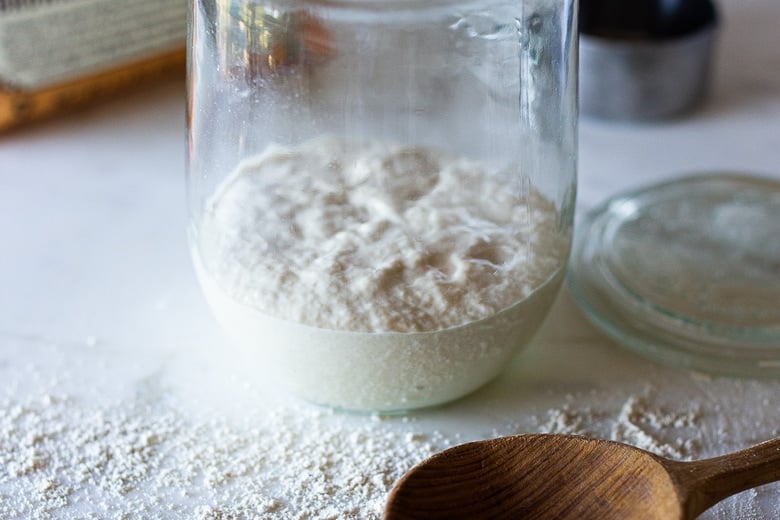
Day 2: After the first 24 hours, there may or may not be a bit of bubbling. Let the mixture rest until you see activity (bubbles or rising) sometimes this takes 36 hours or even 48 hours if very cold. When you see active bubbling, discard all but 1/2 cup of the starter (4 ounces).
To the remaining ½ cup of starter, stir in 1/2 cup water (120 grams), mixing well with a fork and 1 cup of organic bread flour (120 grams) spooned and leveled. Stir until combined. Again, it should feel like a thick paste. If overly dry, feel free to add a bit more water.
Cover again and allow the mixture to sit at room temperature for another 24 hours.
Day 3: After 24 hours, hopefully, you will see some bubbling or rising and if not, let it go a bit longer until you see activity. Be patient.
Depending on how warm your house is and how active your starter, you may need to begin feeding more often or move to two feedings a day, in the morning and at night.
In a nutshell, you want to feed the starter only after it has peaked (metabolized all the flour from the last feeding) and has started sinking down or gets liquidy- this is when it is hungry!
This might be 12 hours, it might be 14, it might be 18, or 24, depending on the temp in your house. In very warm climates it may only be 6-8 hours. In winter, this may take 36 hours. It is better to underfeed rather than overfeed here. For each feeding, like before, discard all but 1/2 cup of the STARTER (keeping roughly ½-cup of starter in the jar) Add 1 cup Bread Flour (spooned and leveled) and 1/2 cup water to the 1/2 cup starter and let this rest at room temperature for 12-24 hours or until the starter looks “hungry” again before repeating.
Day 4: Feed 1-2 times, discarding all but 1/2 cup of starter EACH TIME. Feed 1 cup bread flour, 1/2 cup water. Day four is typical for the starter slow down and stall a bit. This is OK. Just keep going, and look for the hunger signs, and only feed when clearly hungry. This may look like liquid on the top, or very runny starter (to the point where it can easily pour out of the jar). But hopefully, you’ll begin to see some rising and falling. It’s helpful to put the starter in a clean jar each day and mark the beginning level (with a sharpie, string or rubber band) so you can easily see this.
***If for some reason your starter looks like it is still rising at the time of second feeding (at night) and there is no evidence it has fallen or no slide marks, skip this feeding and feed first thing in the morning.
AGAIN, feeding it when it is “not hungry” will basically dilute all the growing yeast and make it lethargic. Better to starve than overfeed.
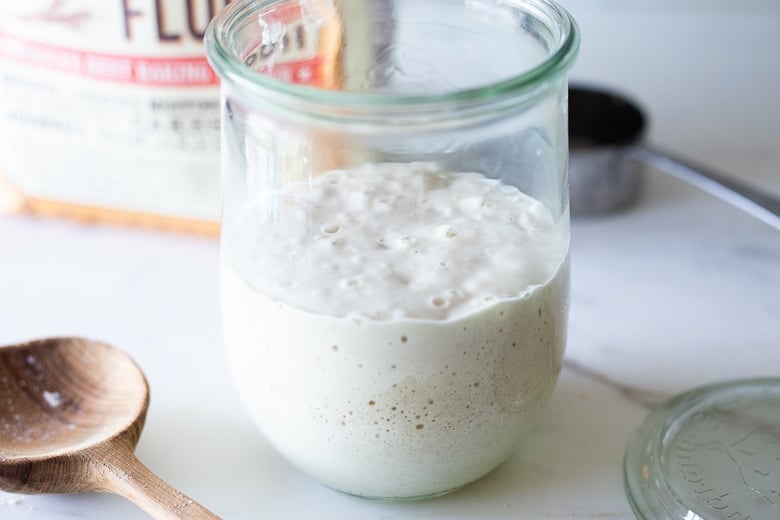
Above you’ll see it peaking, below you’ll see it deflating and getting “hungry”. Feed when the starter only when it’s hungry. This will can vary in time greatly – so even though there is a loose schedule laid out for you here, understand that your starter has a schedule of its own, it is a living thing- so watch it and pay attention!
I repeat: The key here is to watch it. Don’t feed the starter until it looks hungry. Overfeeding a starter makes it lethargic.
Look for the signs of “hunger”: You’ll see watery bubbles at the top or even a layer of liquid. See how below on the jar, how the starter slides down the side of the jar? Look for the “slide” marks just under the Weck logo.
If your starter is not rising and falling, look at consistency. As it metabolizes the flour and gets hungry, it will get runny and liquidy, like to the point where you can pour it right out of the jar. If it is still thick like paste, it’s not done metabolizing (eating)the flour.
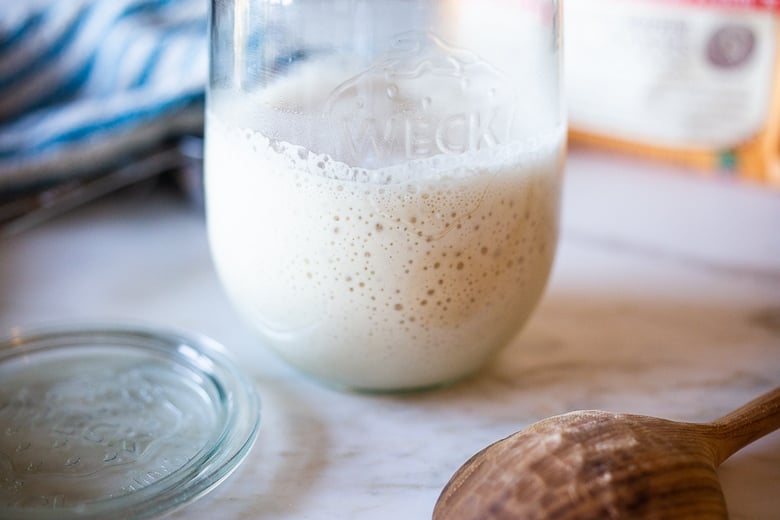
Day 5: Feed again, 1-2 times, roughly 12 hours apart, discarding all but a 1/2 cup the starter EACH TIME. 1 cup bread flour, 1/2 cup lukewarm water. The starter should look visibly active, bubbling, rising, hopefully, close to doubling in size.
You may need to repeat day 5 until the starter is rising and falling predictably and is close to doubling in size within 6-8 hours.
TIP: If your starter is not rising but there is evidence of hunger (liquid at the top) try 3 things: substitute 1/4 cup whole grain flour (add to ¾ cup white bread flour) on your next feeding. Try using mineral water like San Pellegrino instead of water. Stir the starter a couple hours after feeding to allow wild yeast from the room to get in there.
DAY 6: Baking day! Give it one last feeding in the morning. Discard all but a 1/3 cup. ( The reason we are changing this to 1/3 cup is to feed it a little bit more.) Add 1 cup flour (120 grams) and 1/2 cup water, and place it in a clean jar so you can see the action clearly. You can use a sharpie or place a rubber band around the jar to mark the beginning level. The starter should hopefully double in volume within 6 hours of feeding.
Then DO THE FLOAT TEST: To test the starter, place a teaspoon of starter (just from the top, don’t stir it down) in a glass full of water, it should hopefully float. If it does, you can make bread. Tonight! If it doubles in size but does not float, you can still give baking a try. Let the starter rest at room temperature for at least 8 hours allowing it to fully metabolize the flour, perhaps sinking a little before making your dough.
At this point, if your starter does not double in size within 6 hours of feeding, don’t give up! Often, it just takes longer, especially during the winter months. Continue feeding one to two times a day until you see a consistent, predictable rise and fall.
Read the troubleshooting section. If you need to take a break, put it in the fridge and try it again up to a week later. Don’t toss it.
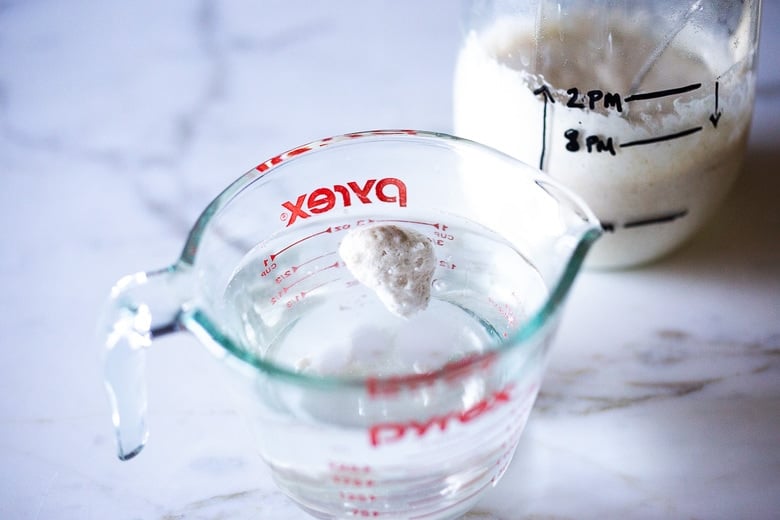
Day 6 EVENING: Use 1/3 cup to make this sourdough bread (if you want)and place the remaining starter (or if not making bread, place all of it) in the refrigerator, and feed it at least once a week, mixing in any liquid at the top, reserving ½ cup starter, before feeding it the usual 1 cup bread flour, 1/2 cup water.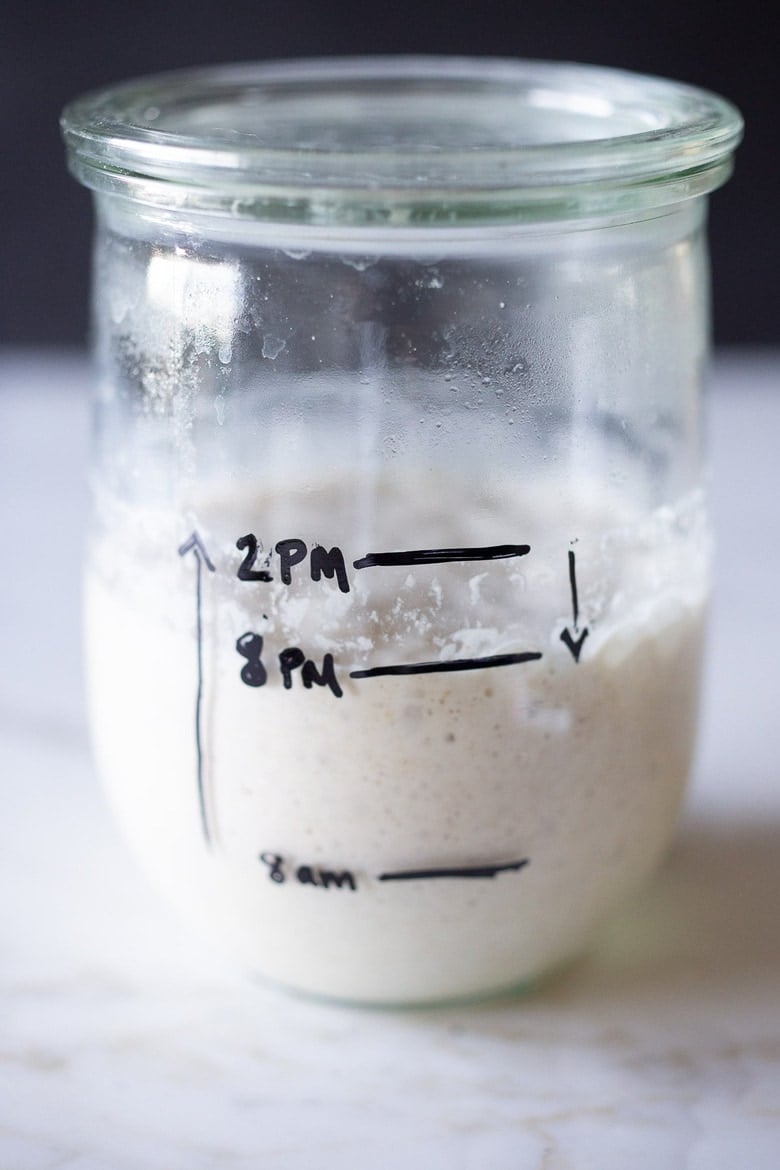
In the photo above, on the 6th day, the starter was fed at 8 am, it doubled at noon, but went even higher until around 2 pm where it peaked. Then as you can see, it started deflating and by 8 pm, it was lower, and “hungry” again. See those downward “slide” marks on the jar?
Look for these! That’s why it’s nice to put the starter in a clean jar so you can see these clearly. They tell you how high your starter went and that it peaked, and now is going down. Even at 8 pm, it passed the “float” test, so I started a loaf of my sourdough bread at this time.
TIP: When making bread, you want to use starter that has already peaked.
Signs of hunger:
- Slide marks (be sure to use a clean jar so you can see these clearly).
- A layer of liquid at the top of the starter
- The starter is thin and liquidy enough to pour out of the jar (when at room temp).
TROUBLESHOOTING:
- SMELL: Starter should smell sweet, tangy, earthy, like a wet horse – not “bad”. If it really smells foul or unpleasant, you may have used an unclean jar, unclean utensil, or somehow introduced other bad bacteria. I would start over.
- NO ACTION: On day 4-5 it is typically for it to slow down. If your starter is not rising at all but there is evidence of hunger (liquid at the top, or bubbles) try 3 things. First substitute 1/4 cup whole grain flour (add to ¾ cup white bread flour) on your next feeding. If no rise, then try using mineral water, specifically San Pellegrino instead of water. San Pelligrino specifically has the right mineral ratio, I have great luck with it. Others not so much! Also try stirring the starter a couple of hours after feeding, a couple of times throughout the day to allow wild yeast from the room to get in there. Lastly, you could try pineapple juice instead of water.
- FLOUR: Try to use fresh milled whole grain flour to start, then organic BREAD FLOUR. The more wild yeast in the flour, the better your starter will do- so smaller brands like Bob’s Red Mill seem to do better than bigger conventional brands that have been overly processed. It is totally OK to mix flours and to switch them up- this adds different kinds of wild yeast- a good thing!
- DO NOT overfeed. For example, maybe feeding 2 x day at 12-hour intervals is too often. You want to feed after the starter has peaked, then deflated (see photo above- you’ll see some slide marks on the jar) and this tells you that it is hungry. If you feed the starter before it has had a chance to metabolize (or eat) all the flour (before peaking) and then you discard part of it, and feed it again, you are actually diluting all that amazing bacteria, weakening your starter. So it’s all about watching your starter in your home. If you are not seeing rising and falling, but notice the starter just gets liquidy, this too is a sign of “hunger”. Or if it gets runny enough to pour out of the jar, another sign it is hungry. There are lots of variables here. Just be patient, pay attention and watch. This is a living thing- it doesn’t care about time schedules and recipes or what it “should” do. It will “eat” when it is “hungry” and sometimes it likes to eat slowly. 😉
- TIME: It may take longer than 6 days in colder environments. Use a kitchen thermometer and take its temp. Is it over 65F? Find a place where it can be warm. In the oven with the light on, or in an upper cupboard ( heat rises). Sometimes it takes 12-14 days! Be patient, keep going. If it is doing absolutely nothing, leave it out on the counter for 24-48 hours and see what happens. If you run out of flour or need a break, don’t just toss it, put it in the fridge and see if you can get it going a few days later.
- ACIDITY: If you still can’t get that starter going, some people recommend subbing pineapple juice for the water for one feeding- raising the acidity level. My good friend just tried this and it got hers going.
- LIQUID: If you see any liquid at the top of your starter, it means your starter is hungry. So, yes it’s still alive which is a good thing! You can stir the liquid in, or pour the liquid out, either way, but feed it. This is a sign that you may need to feed it more often.
- MOLD: if you see any discoloring or mold on the surface, starter was probably contaminated. If it is only on the surface, it is probably ok to save. Scrape it off, save 1/2 cup of the underneath starter, and keep going, using a clean jar. Feed, smell, use your best judgment.
- FLOAT TEST: Try testing when your starter is peaking. Take a spoonful from the top without stirring it down. If your starter is rising and falling consistently, but not passing the float test and it has been over 8-10 days- just try baking a loaf. People are having luck with good loaves without passing the float test. It may be the flour…
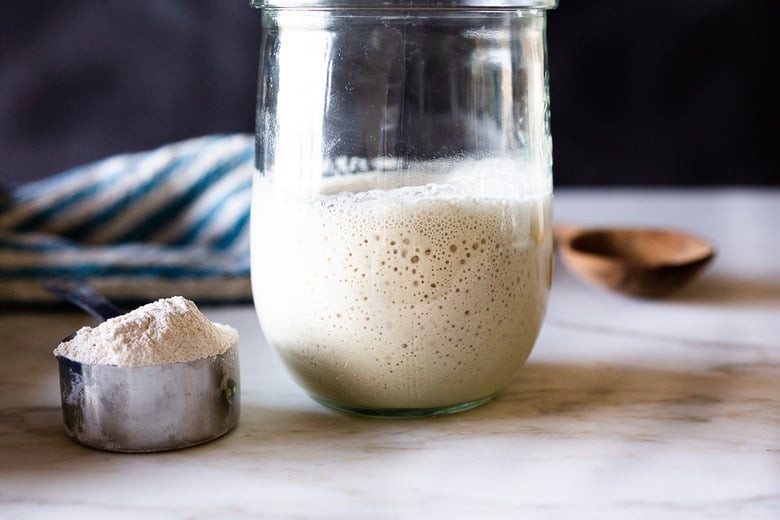
How to Maintain Your starter:
- REFRIGERATE & FEED AT LEAST ONCE A WEEK: Pick a scheduled day and try to stick with it, always reserving 1/2 cup and feeding it 1 cup flour and 1/2 cup water. Discard the remaining, give it away, or keep the discard in a separate container for waffles, pancakes, sourdough buns, banana bread, biscuits, etc. I usually don’t feed the discard unless I give it away.
- If you forget to feed it one week, it is most likely OK; feed it 1-2 times a day for 1-3 days in a row to revive it (keeping it out on the counter) until bubbly and active and doubles within 6 hours. I’ve left my starter for a month on vacation (in the fridge) without feeding and simply revived it by feeding it 3 days in a row, 1-2 x day. It’s surprisingly hard to kill. You can also freeze it for more extended storage.
- This batch will allow you to bake 2 loaves of bread per week with enough left to feed for the next week. If you find yourself wanting to bake more often, you can keep it out and feed it 1-2 x daily. Or if baking every few days, you can pull it out of the fridge, feed it 10 hours before using, leaving it out, use what you need while it is peaking (or slightly after), then put it back in the fridge that evening. Do the same thing a few days later when ready to use again. So this would be feeding 2-3 times a week, best if baking 4-5 times a week.
Tips on Sourdough Starter:
-
- TEMPERATURE: The colder your home, the longer it will take for the starter to grow and become active (bubbles). Find a warm spot (70-80 degrees) for the best results. On the stovetop, with the light turned on, or on top of the fridge. Or in the oven with the light on. On top of a heating pad (set to low) with a towel in between). You can still make the starter in a colder home, it will just take longer- even up to 2 weeks! Test the temp of your starter using a thermometer.
- FLOUR: Always try to start the batch by using organic whole-grain flour (wheat or rye) because it has more wild bacteria in it than white flour and will get it active and growing sooner. Freshly milled works exceptionally well. You can, of course, continue to use whole grain, but I just use organic white “bread” flour for days 2 through 6, less costly. You can also feed with organic all-purpose flour, but I’ve had much better luck with getting the starter stronger, faster, starting off with the wholegrain the first day, and using bread flour for the remaining. UP to YOU. You can always mix in a little whole grain with the white as well if your starter looks like it needs a boost.
- WATER: Sometimes chlorine in tap water can inhibit the growth of your starter. Some people leave tap water out, in an open container overnight to allow some of the chlorine to evaporate. Using lukewarm water helps fermentation to start faster. Try Mineral water, like Perrier, it seems to work wonders too! Sometimes bottled water can be overly sterile- so using mineral water (carbonated is OK) is a good option.
- HYDRATION: Hydration refers to the ratio of water to flour in terms of weight. It is a ratio. For starter, this is typically at 100% hydration. Meaning if you use 120 grams of water, use 120 grams of flour. This roughly translates to 1 heaping cup of flour and 1/2 cup water. Feel free to weigh instead of measure if you want to be more precise or want to familiarize yourself with the consistency. It’s nice to do this the first time to get a feel for it.
- STORING AND FEEDING: When your starter is kept cold, like in the fridge, you don’t need to feed it as often- only once a week. If you keep it out on the counter, you’ll need to feed it 2 x daily. Cold slows down the fermentation, and heat speeds it up.
- USING: When you need to use your starter for baking bread, feed it 4-8 hours before making bread dough, using it right at peak height or slightly after (even better).
- Do I REALLY have to discard my starter? YES. I know it seems wasteful- but while you are building your starter, during the first week, it is the simplest easiest, fastest and most economical way to create healthy a starter. This is because you always have to feed it 2 times its volume!!! If you keep the 1 1/2 cups starter, you would have to feed it 3 cups (instead of keeping just a 1/2 cup and only feeding it ONE cup). Get it? 😉 Doing this will shorten the fermentation process, require less flour in the long run, and create a stronger starter. Once the starter is “established” after the first week- then you don’t need to discard it but can use it in bread baking, pizza dough, scones, biscuits, waffles, sourdough buns, etc.,- or give it to a friend.
Signs of Hunger:

The photo above was taken after the starter was fed, peaked 4 hours later (reached its highest), and now is” hungry” again. The perfect time to use it in bread! See the downward slide marks on the jar. Again, pay attention to these- your starter is telling you what it needs. You just have to learn how to see it.
I hope you have fun with this simple little Sourdough project! In the coming weeks, I’ll put out some fun recipes to make with your sourdough starter! Also, watch the new step-by-step Sourdough Video above!
How to use your Sourdough Starter!
- No-Knead Sourdough Bread
- Sourdough Baguettes
- Sourdough Scones
- Sourdough Crackers
- Sourdough Biscuits
- Sourdough Buns
- Sourdough Tortillas!
- Vegan Banana Bread
- Overnight Sourdough Waffles
- Sourdough Pancakes
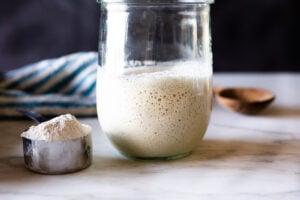
Simple Sourdough Starter
- Prep Time: 30
- Cook Time: 6 days
- Total Time: 144 hours 30 minutes
- Yield: 1 ½ cups 1x
- Category: sourdough, fermented, cultured, bread, baking,
- Method: fermented
- Cuisine: bread
- Diet: Vegan
Description
How to make your own Sourdough Starter (see the step-by-step video in post) using simple ingredients with no special equipment, in 6 days, that can be used in sourdough bread. Sourdough Starter is a wild yeast, made from fermenting flour and water.
Ingredients
- 120 grams whole grain flour (whole wheat flour, rye flour, or freshly milled flour) 1 cup, fluffed, spooned and leveled
- Organic White Bread Flour (5-10 lb bag ) I like Shepherd’s Grain or Bob’s Red Mill.
- 120 grams Water per feeding (1/2 cup water)
Instructions
-
- Day 1: Starting in the morning or at night, using a wide-mouth quart jar or Crock or Glass Measuring Cup mix 1 cup whole grain flour (120 grams) with 1/2 cup (120 grams) filtered water using a fork making sure you’ve incorporated all the dry flour. For your first measuring – it is a good idea to weigh the flour, using a kitchen scale so you get an idea of how thick it should feel. It should be like a thick paste. Thick like peanut butter. If you need to add a little more water to incorporate the flour, that is OK, but be precise with the flour. Place the lid on top (using the Weck jar is really handy here) or a damp towel to keep moisture in, or plastic wrap- and let sit at room temperature (70-80 degrees) on the kitchen counter for 24-48 hours, or until you see some bubbling. If you are not sure how warm it is, use a kitchen thermometer and check it a few hours later. See notes for TEMPERATURE.
- Day 2: After the first 24 hours, you may or may not see a bit of bubbling. I prefer to let this rest until I see a tiny bit of activity (bubbles) and sometimes this takes 36 or up to 48 hours. So start “day 2”, when you see a little bit of bubbing. Discard all but 1/2 cup (136 grams) of the starter. (See notes for discard). Add to the remainder, 1 cup of white bread flour, (120 grams), spooned and leveled, and 1/2 cup filtered water (120 grams), mixing well with a fork. Place the lid on loosely again and allow the mixture to sit at room temperature (70-80F) for another 24 hours.
- Day 3: By the third day, you should definitely see some bubbling- and if not, let it go a bit longer. Depending on how warm your house is and how active your starter, you may need to begin feeding more often, or even move to two feedings a day roughly 12 hours apart, like in the morning and at night. In a nutshell, you want to feed the starter only after it has peaked (metabolized all the flour from the last feeding) and has started sinking down or gets liquidy- this is when it is hungry! This might be 12 hours, it might be 14, it might be 18, or 24, depending on the temp in your house. In very warm climates it may only be 8 hours. It is better to underfeed rather than overfeed here. For each feeding, like before, discard all but 1/2 cup of the STARTER (keeping roughly ½-cup of starter in the jar -4 ounces or 136 grams) Add 1 cup Bread Flour (spooned and leveled) and 1/2 cup water to the 1/2 cup starter and let this rest at room temperature for 12-24 hours or until the starter looks “hungry” again before repeating.
- Day 4: Feed 1-2 times, discarding all but 1/2 cup of starter EACH TIME. Feed 1 cup bread flour, 1/2 cup water. Look for the hunger signs. Hopefully, you’ll begin to see some rising and falling. It’s helpful to put the starter in a clean jar and mark the beginning level (with sharpie, string or rubber band) so you can easily see this. ***If for some reason your starter looks like it is still rising at the time of second feeding (at night) and there is no evidence it has fallen or no slide marks, it is still “eating” so skip this feeding and feed first thing in the morning. AGAIN, Feeding it when it is “not hungry” will basically dilute all the growing yeast and make it lethargic. Better to starve than overfeed.
- Day 5: Feed again, 1-2 times, roughly 12 hours apart, or when hungry, discarding all but a 1/2 cup the starter EACH TIME. 1 cup bread flour, 1/2 cup lukewarm water. The starter should look active, bubbling, rising, sliding down, hopefully, close to doubling in size. (If not, repeat this day until starter doubles in size within 8-12 hours of feeding- and read the troubleshooting section.)
- DAY 6: Give it one last feeding. Discard all but a 1/3 cup. Add 1 cup flour ( 120 grams) and 1/2 cup water, and place it in a clean jar so you can see the action clearly. You can use a sharpie or place a rubber band around the jar to mark the beginning level. The starter should hopefully double in volume within 6 hours of feeding. When it peaks, DO THE FLOAT TEST: To test the starter, place a teaspoon of starter (just from the top, while it is peaking, don’t stir it down) in a glass full of water, it should hopefully float. If it does, you can make sourdough bread. Tonight! Let the starter keep resting at room temperature or a few more hours allowing it to fully metabolize the flour, perhaps sinking a little before making your dough. You want to make dough with slightly hungry starter. Place the remaining starter in the fridge and feed it in a week. You’ll have enough stater to make one more sourdough loaf during the week, and still have enough to feed. If you want to wait to make bread until later in the week place starter in the fridge. Be sure to feed it in 7 days. Read maintenance section.
- At this point, if your starter does not double in size don’t give up! Often it just takes longer, sometimes up to two weeks, especially if it’s cold. Continue feeding one-two times a day (only when hungry) for a few more days, until you see a visible rise and fall. Read the troubleshooting section. If you need to take a break, just put it in the fridge and try it again up to a week later. Don’t toss it- if there are bubbles, it is still alive.
- This batch of starter will make two loaves of bread with enough left over to feed for the following week.
TROUBLESHOOTING:
- STALLING: It is typical to see a “stall” on day 4 or 5. If your starter is not rising but there is evidence of hunger (liquid at the top) try 3 things: substitute 1/4 cup whole grain flour (add to ¾ cup white bread flour) on your next feeding. Try using mineral water like San Pellegrino instead of water. Stir the starter a couple hours after feeding to allow wild yeast from the room to get in there.
- SMELL: Starter should smell slightly sweet and tangy, and not off or “bad”. To me, it smells like a wet horse;) If it smells VERY unpleasant, you may have used an unclean jar, or an unclean utensil, or somehow introduced another foreign bacteria. I would start over.
- TOO MUCH ACTION: if your starter overflows from the jar, this is a good sign,(not bad) it is alive and active. This often happens in warm climates. You’ll need to feed it more often or find a cooler spot. Even if it floats on day 2-3, please keep feeding it the full 6 days before using it to make bread. It will add more flavor and complexity.
- CONSISTENCY: Thick or Thin? If you have been careful about measuring feedings, but are not seeing rising or falling, another way to tell what stage of your starter is in is to look at the consistency. If the starter seems really thick, it is still “digesting”. If it seems loose or runny or liquidy, (to the point where you can pour it out of the jar) it has digested all the flour and is now “hungry”. It loosens up as it metabolizes the flour. So even if you don’t see rising or falling, look for consistency to give you clues.
- DO NOT overfeed. For example, maybe, feeding 2 x day at 12-hour intervals is too often. You want to feed after the starter has peaked, then deflated a little or is runny (see photo above- you’ll see some slide marks on the jar) and this tells you that it is hungry. If you feed the starter before it has had a chance to metabolize (or eat) all the flour and then you discard part, and feed it again, you are actually diluting all that amazing yeast. Get it? So it’s all about watching your starter in your home. There are lots of variables here. Just be patient, pay attention and watch. This is a living thing- it doesn’t care about time schedules and recipes or what it “should” do. It will “eat” when it is “hungry” and sometimes it likes to eat slowly.
- It may take longer than 6 days in colder environments. Use a kitchen thermometer and take its temp. Is it under 65F? Find a place where it can be warm. Or use lukewarm water when mixing. Place it in the oven with the light on overnight. (Not in direct sunlight) or above the fridge, or on the stovetop. Sometimes if cold, it takes 10-12 days. Be patient, keep going. If it is doing absolutely nothing, leave it out on the counter for 24-48 hours and see what happens. If you see bubbles, it is alive and can be coaxed. If you run out of flour or need a break, don’t just toss it, put it in the fridge and see if you can get it going a few days or up to a week or two later.
- ACIDITY: If you still can’t get that starter going, some people recommend subbing pineapple juice for the water for one feeding- raising the acidity level. My good friend just tried this and it got hers going.
- LIQUID: If you see any liquid at the top of your starter, it means your starter is hungry. So, yes it’s still alive which is a good thing! You can stir the liquid in, or pour the liquid out, either way, but feed it! This may be a sign that you may need to feed it more often than you are.
- MOLD: if you see any discoloring or mold on the surface, the starter was probably contaminated. If it is only on the surface, you could salvage it. Scrape it off, save 1/2 cup of the underneath starter, and keep going. Feed, smell, use your best judgment.
- FLOAT TEST: If your starter is consistently rising and falling and it is has been over 8 days, but still doesn’t pass the float test, try baking a loaf of bread anyway. Remember, use hungry starter when mixing up the dough.
MAINTENANCE:
- REFRIGERATE & FEED AT LEAST ONCE A WEEK: Pick a scheduled day and try to stick with it, always reserving 1/2 cup starter (130 grams) and feeding it 1 cup flour (120 grams) and 1/2 cup water (120 grams). Discard the remaining, or give it away, or keep the discard in a separate container to use in waffles, pancakes, sourdough buns, banana bread, biscuits, etc. I usually don’t feed the discard unless giving away.
- If you forget to feed it one or two weeks in a row, it is most likely OK, just feed it 1-2 x day for 1-2 days in a row to revive it (keeping it out on the counter) until bubbly and active. I’ve left my starter for a month on vacation (in the fridge) without feeding and simply revived it by feeding it 3 days in a row, 2 x day. It’s actually kind of hard to kill. You can also freeze it for longer storage.
- If you find yourself wanting to bake more often than once a week, you can keep it out and feed it 1-2 times daily. Or if baking every few days, you can pull it out of the fridge, feed it 8-10 hours before using, leaving it out, use what you need while it is peaking, then put it back in the fridge that evening. Do the same thing a few days later when ready to use it again. So this would be feeding 2-3 times a week, best if baking 2-3 times a week.
Notes
- TEMPERATURE: The colder your home, the longer it will take for the starter to grow and become active (bubbles). Find a warm spot (70-80 degrees) for the best results. On the stovetop, with the light turned on, or on top of the fridge. Or in the oven with the light on. On top of a heating pad (set to low) with a towel in between). You can still make the starter in a colder home, it will just take longer- even up to 2 weeks.
- FLOUR: Always try to start the batch by using organic, freshly milled whole-grain flour (wheat or rye) because it has more wild yeast in it than All-Purpose or white flour and will get it active and growing sooner. You can, of course, continue to use whole grain, but I’ve had the best luck using organic “bread” flour for days 2 through 6. People have made a sourdough starter with All-Purpose flour- but personally, this has never worked for me– there are fewer nutrients and wild yeasts in the flour and results in a very lethargic starter. If it is your only option, try mixing in 2+ tablespoons of whole-grain (wheat or rye) with the AP flour per feeding. Feel free to use different flours or mix different flours together. It is OK to use all-purpose flour if in a pinch, but using it repeatedly will result in sad starter.
- WATER: I usually use tap water -but sometimes the chlorine in tap water can inhibit the growth of your starter. Lukewarm water helps fermentation to start faster. Sterilized bottled water is often overly sterile, and can also inhibit. Mineral water, like Perrier (carbonated is OK) can sometimes work miracles.
- HYDRATION: Hydration refers to the ratio of water to flour in terms of weight. It is a ratio. The starter is typically at 100% hydration- meaning equal parts flour and water, in terms of weight. So if you use 120 grams of water, use 120 grams of flour. This roughly translates to 1 cup of flour and 1/2 cup water. Feel free to weigh instead of measure if you want to be more precise, or want to familiarize yourself with the consistency you are aiming for. If using whole grain flours (which tend to be “thirstier”) and your starter seems very thick, it is totally OK to add more water to thin it a bit. I intentionally keep the hydration a little lower here (a thicker starter) so you can more clearly see the rise and fall “action” in the jar.
- STORING AND FEEDING: When your starter is kept cold, in the fridge, you don’t need to feed it as often- only once a week. Feel free to feed it “cold”, and put it right back in the fridge if you like. If you keep it out on the counter, you’ll likely need to feed it 1-2 x daily (or just watch and feed only when hungry). Cold slows down the fermentation, heat speeds it up.
- USING: When you need to use your starter for baking bread, feed it 10-12 hours before making bread dough, using it after its peak height. For a more “sour” flavored bread, use the starter straight from the fridge, 3-6 days after feeding. The starter gets more sour tasting the longer it goes without feeding. Feeding the starter the same day as making bread will produce a milder sourdough flavor.
- Do I REALLY have to discard my starter? BASICALLY YES. I know it seems wasteful- but while you are building your starter, during the first week, it is the simplest, easiest, fastest, and most economical way to create healthy a starter. (Or save it separately -in the fridge- and use it in Pancakes, Waffles, Buns, or Biscuits. ) This is because you always have to feed it 2 times its volume in flour. For example-if you kept all the 1 1/2 cups of starter, you would have to feed it 3 cups of flour (instead of keeping just a 1/2 cup and only feeding it ONE cup). Doing this will shorten the fermentation process, require less flour in the long run, and create a stronger starter. Once your starter is “established” after the first week- then you can give it away to friends, use it in pizza dough, banana bread, waffles, pancakes, buns, etc) or give it to a friend. If you would like to save your “discard” during the first week – use it as you would flour and water, not expecting any rise.
- HOW TO USE YOUR SOURDOUGH STARTER/Discard :
- No-Knead Overnight Sourdough Bread (only if it passes the two “tests”)
- Overnight Sourdough Waffles
- Sourdough Pancakes
- Sourdough Scones
- Sourdough Biscuits
- No-Knead Sourdough Bread – only after day 6
- Vegan Banana Bread
- Sourdough buns
Save the sourdough “discard” in a separate container in the fridge.
Nutrition
- Serving Size: 1 tablespoon
- Calories: 31
- Sugar: 0 g
- Sodium: 0.2 mg
- Fat: 0.1 g
- Saturated Fat: 0 g
- Trans Fat:
- Carbohydrates: 6.2 g
- Fiber: 0.2 g
- Protein: 1 g
- Cholesterol: 0 mg


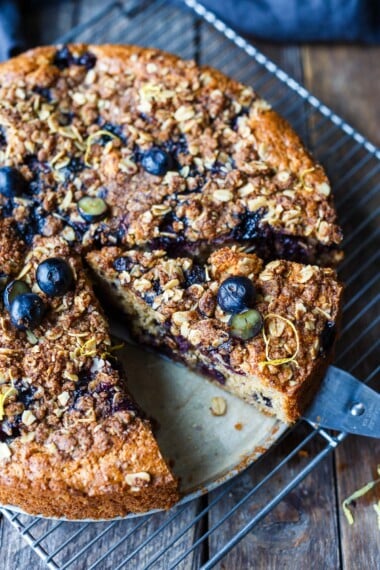




Hey Ms Sylvia… Thank you soooo much for this amazing starter tutorial. I have tried in years past to do this – but unsuccessful each time. This time, my first effort was a failure also, but I think I may have figured out what the problem was. We live in South Florida – it’s a very hot summer right now – and our air conditioning never seems to stop. I don’t think my starter likes the movement of the A/C air even though the jar is covered. So, I cleaned out a cupboard on top of my microwave (which is over top of my stove) and use that to let my starter “sleep” behind closed doors with reduced air movement – and voila! Success – HUGE success actually. Thank you sooooo much for taking the time to do this. Can’t wait to bake my very first loaf in a couple of days. Yipeeeee
Awesome Joanna!
Love your sour dough bread recipe, perfect !!!!!! Make pancakes with discard every time, family can’t get enough.
Have a question why do you feed your starter with half water to flour when others say equal flour to water?
Also do you have a sour dough suggested Focaccia recipe ?
Feel free to increase the water. 🙂 I don’t have one for focaccia but it is a great idea!
Hi! Your methods and explanations are very well done. Thank you so much! I am just confused because on Day 3 evening of your video the starter had not fallen with slide marks… only bubbling…and you fed it again. I didnt see that in the notes as I made my first starter so I never fed it when it bubbled on the 5th day because I didn’t see slide marks. It ended up dying after a couple of days of no feeding so I made another one and it’s SO much better! (1st whole grain flour I used was years old lol.)
This time should I do what you did and feed when it bubbles instead of waiting for slide marks? Thank you!!!
Hi, I was wondering when someone would notice that! 🙂 Yes, technically I should have waited. You’ll see I ended up skipping a feeding the next day in the video. SO….YES, I would wait until it looks hungry. On the way down with slide marks or gets slightly liquidy.
Thank you so much for getting back to me! Ok, because yesterday it rose so high and slid down and bubbled but now it’s been 24 hours and it’s only risen a bit and bubbled…no slide marks… so even though it’s been 24 hours, keep waiting?
Wait until it is liquidy. 😉
Thank you so much, Sylvia! God bless you!
Great explanation for a total novice- thank you!
Starter now bubbling away happily.
Awesome, great to hear Mark! 🙌
Sylvia – super helpful recipe and videos! Thanks! We are trying our best here but need some advice. We are on trial 3 with a starter. That is a long story. I have read through the comments and think we need more advice! We followed your recipe this time – day 1 – great – quadrupled in size! Fed because seemed hungry – AP Flour! day 2 – tripled in size – and went down – fed again at the 12 hour mark because it had the streaks from growth down the side of the jar – seemed hungry! Fed AP Flour. Did not grow much – got the liquid at the top. So, after 12 hours – I mixed the removed liquid – it was clear not brown, fed AP – still not happy, no raising – but there was light bubbling and liquid – fed – AP. Next 12 hours – fed mix of whole wheat and AP flour to help it – still bubbling lightly but not growing, liquid formed. Left 24 hours. Fed whole wheat – grew a little, still bubbling, liquid formed. Fed only whole what – grew about half as much as consistency is – and is forming liquid again – still has bubbles. We have completely switched to whole wheat flour; we leave the water out overnight so there is no chlorine impact, the house is about 77-80 degrees (we are in Florida). I am not sure why the liquid keeps forming and the growth is not as successful as the first two days? What are we missing? Smell seems fine. We are following your video and I really thought the switch back to whole wheat would do the trick. Since it is not doubling in size I am worried something isn’t right? I see bubbles so I know something is happening……Thanks for your advice!
Hi Allison.:) It sounds like you are doing everything I would do? The liquid and bubbles are a good sign. Sometimes it just takes a while to see that rising. It is definitely processing and metabolizing. Just be patient. Only feed when hungry. Maybe next time you go to store, pick up bottled water, bread flour (or a little rye) and even a small container of pineapple juice? If you get tired of feeding it, put it in the fridge for a 5-7 days, take a break and try feeding again. Someone told me recently that chorine in tap water, doesn’t evaporate. Not sure who to believe. Conflicting info… Anyways, You can do this. Don’t give up. 🙂
Total success! Made bread earlier this week! Thanks so much for your help!!
Yay!!! Glad it worked!
Dear Sylvia, thank you so much for the recipe! Could sourdough starter be considered as “baker’s yeast”? And can it be used instead of yeast in sweet pastry such as brioches, etc?
That is a great question and honestly-I’m not sure. Does anyone else know the answer to this?
I’m on my second try at the starter 24 hours in and it looks bad to me. Kind of a dark gray on top and little brownish liquid on top of the lump in places. I wanted to attach pictures, but can’t see how to accomplish that. Fresh stone ground, organic whole wheat flour and reverse osmosis, filtered water. Temperature of lump is 71.9 F. I do live at 7060 ft above sea level…don’t know if that makes a difference. Any thoughts?
It sounds hungry. Not bad, just keep going and feed it. 🙂
Hi Sylvia!
I finally have starter that floats! It took 12 days, but it is finally ready! I’m so excited to make bread!
I have a few questions though. I don’t feel that I have a clear understanding about using the starter and what to do with it now.
1. When I take out enough starter to make the bread, do I then put the remainder in the refrigerator? Do I feed it first? How do I maintain enough starter to continue making bread? I am uncertain about the maintenance of the starter after I take out enough to make the bread.
2. I am not going to make bread until tomorrow. Do I feed it tonight and keep it out on the counter until I’m ready?
3. Do you have tips for making the bread more sour right away, or is it just a starter maturity thing?
Thank you for your assistance and for your great website!
Hi sorry for the delayed response. Congrats to you!!! Please read the “Maintainance” section on the recipe card. And Notes for more sour bread. If making bread tomorrow, you could yes feed it tonight and leave it out. Or place already fed and metabolized starter in the fridge and use it cold straight from the fridge. The key is, you want to use starter that has peaked and is slightly (or very) hungry -for making dough.
Love this. A friend and I both made our starters at the same time. I’ve given a few away and have my third generation of starters myself.
Love this. A friend and me both made our starters at the same time. I’ve given a few away and have my third generation of starters myself.
Perfect! That’s the fun of it- giving it away. 🙂
Greetings! I am enjoying my sourdough bread making and have been delighted that you’ve provided such clear and complete instructions. But here’s my question: I fed my starter mid-afternoon with a plan to begin making bread this evening. The starter is perfect to begin now, but I am not. What to do next? Put the starter in the fridge for tomorrow? Leave it on the counter all night? (I don’t think so.) Can I start over tomorrow morning with the chilled starter (after letting it rest until it’s peak) or toss out the usual amount and feed it again waiting the 4-6 hours?
Hi put it in the fridge, use what you need tomorrow, cold, feed it in a week.
My starter is very stretchy. Should I worry?
No. 🙂
I don’t know what I’m doing wrong, but I’m on my third try and each time I start out with bubbling that ends on the 2nd or 3rd day and my starter goes flat. I sterilize my jars, use reverse osmosis purified water, measure ingredients using a scale, organic whole wheat followed by organic flour (whatever I can get my hands on in Sprouts) and intense observation for feeding (the slide). House is at a pretty constant 77 degree temp. My thought is that other bacteria (perhaps leuconostoc) are taking over and preventing the natural yeast from proliferating. My next step is to use my pH meter to add an acidic ingredient that may prevent opportunistic bacteria from proliferating. I have been using the discard successfully though 🙂
Hi Maggie, are you using AP flour? Try mixing in whole wheat. Let it go longer. Don’t toss at day three even if flat. Let it get really runny before feeding.
If I use discard, does it need to be at room temperature?
No! 🙂
Thanks . Very helpful and clear
Hi Sylvia! Thank you for a great starter recipe.
I started this a week ago and things were going well. However, the starter keeps forming a thick almost crusty layer at the top with a bit of liquid, while the button is liquidy. I am not sure if that’s a sign of anything?
I am using strong whole wheat flour.
Thanks!
how are you covering it?
Thanks for the details… managed to get my starter working and trying on the path of making some bread now… all this while the starter has been let outside… and given that I may only make bread once or twice a week, I would like to keep the starter I. The fridge… when do I put it in the fridge… immediately after feeding? When the starter peaked? or when it falls down again.
I’ve fed the starter 4 hours ago and it has doubled… should I have put it in the fridge immediately after feeding?
Thanks!
You can put it in the fridge right away, if not making bread that same day. If making bread the same day you feed, leave it out until it peaks, then use the starter for bread, put remaining in the fridge. 🙂
Thanks!
Simply wow! Here on Indian the heat and humidity worked perfectly on your oh-so-amazing recipe. I began the starter last night and morning it had risen really high. I fed it then and came back in the early evening to find it had risen so much it had breached the cloth lid and spilled out. A happy problem Im sure. Thrilled to have this little hungry monster around. Thank you so much.
Definitely a happy problem! Healthy and happy, yes!
If I continue to discard all but 1/2 cup of starter each time I feed it, how will I ever have enough starter to share with others?
Once your starter is going, after the first week, you can give the discard away to friends. 🙂
How bout if my starter smells like acetone, but has no hooch. On top. Is it ready to feed? And how long does it take for the smell to away?
I’d say it is hungry. Feed it, the smell should go away after feeding.
I am on day 10 or 11 and still nothing. I started with whole wheat flour and the all purpose. I had bubbles and it smelled fine. Today I had no bubbles it had risen and fell slightly so I fed it again. Still nothing. Our kitchen temp is perfect. What am I doing wrong?
You are doing nothing wrong. 🙂 So it sounds like the flour to me. Are you mixing whole wheat with the AP flour? Or just straight AP? Try letting it go extra long, let it get really runny, then feed with only whole wheat and see what happens.
Hi! First of all, I have shared this guide many times because it is spot on and absolutely helpful! I plan on leaving my starter out, and you indicated that I should feed it two times a day. How much do I feed it? thank you!
Feed the normal amount. Only feed when hungry. It might NOT always be 2 x day.
I don’t see the notes for temperature of the starter!
it happiest between 68-80
Third time trying to make the Sourdough Starter, first time using your recipe.Total success. Excellent explanation, great tips.
Thanks
YAY NANDO!!! 🙌
Great explanations and demonstration, resulted in me having success when I made your no knead sour dough bread. ( First time for me)
This has opened a whole new world for me and has lifted my spirits during these difficult times, so thank you, thank you, thank you.
Be well,
Thanks Gillian! Glad it worked out!
Every time I try to add a heaping cup of whole wheat flour to a half cup of water I get a clump of dough that no amount of mixing will turn into your beautiful thick liquid. What am I doing wrong? :(((
My bad. It’s not you! Please weight the flour. Or try “spoon and leveling”. I updated the recipe, to remove “heaping” ( that was an issue) so reprint newer updated version. Sorry about that.